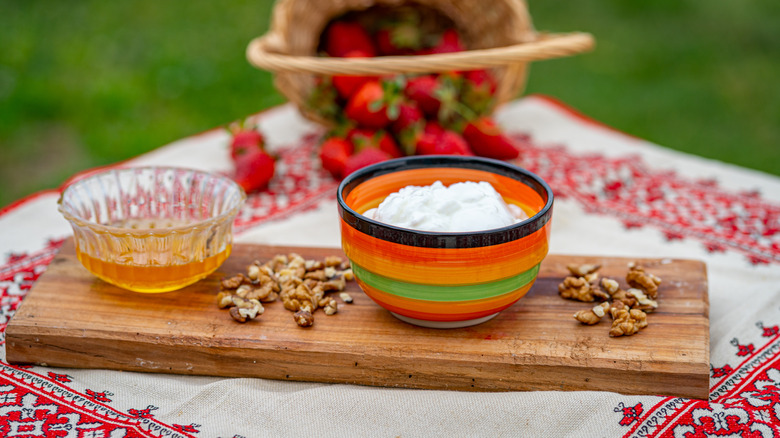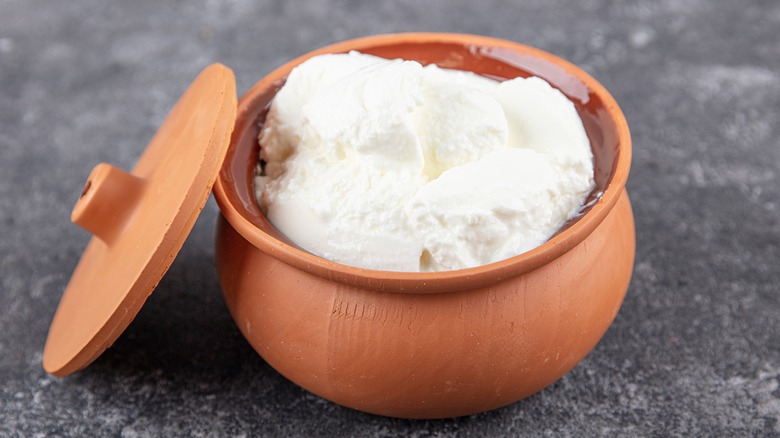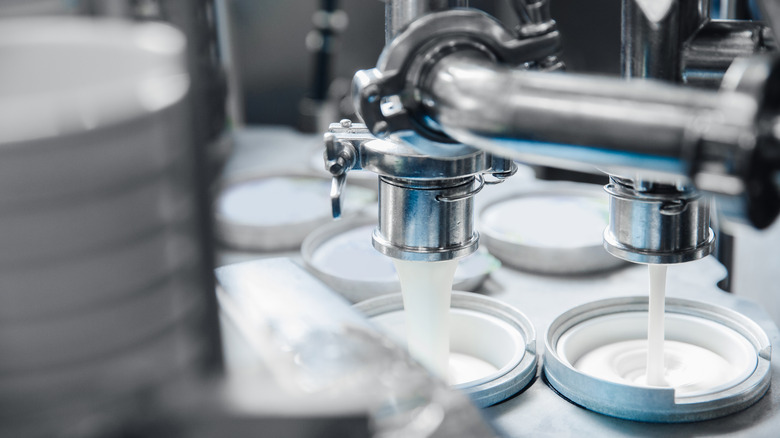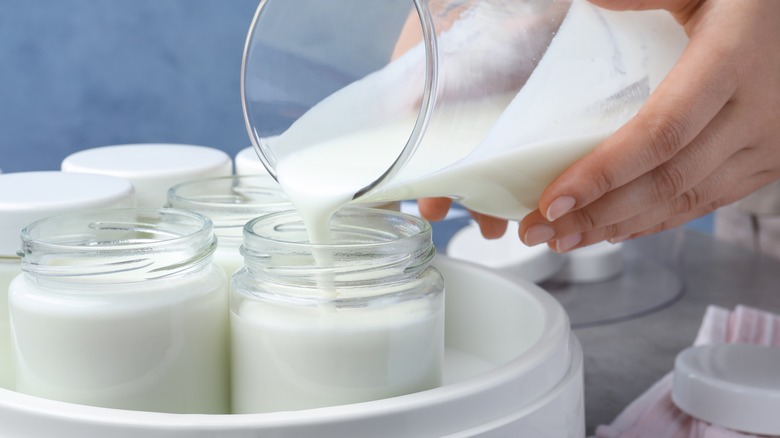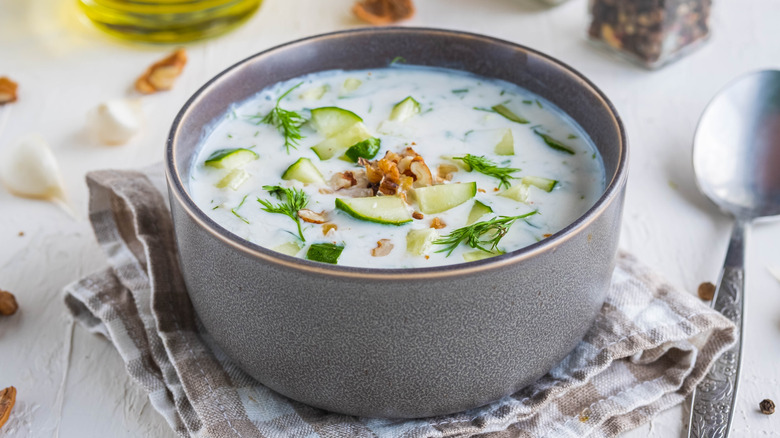What Makes Bulgarian Yogurt Unique
While bacteria can be associated with health risks (they're a big reason why home cooks need to know food safety tips), certain types are integral to some delectable creations. Humans have used microbes for millennia to make everything from cheese to bread to beer. Not only do these microorganisms create appetizing flavors and textures, but they also help to preserve food and boost its nutritional value, per the European Food & Fermentation Cultures Association.
Bacteria's magical culinary repertoire also includes yogurt — formed when the microbes convert the lactose, or dairy sugars, in milk, Scientific American explains. The result of this fermentation is lactic acid, which creates the thick consistency and tangy taste that yogurt lovers enjoy. Manufacturers choose from an array of many different strains for the process, the specifics of which can usually be found on the back of the product label.
Varying techniques, fermentation methods, and starter cultures are what distinguishes one type of yogurt from another. However, in the tantalizingly tart Bulgarian yogurt, the bacteria used — Lactobacillus bulgaricus and Streptococcus thermophilus — are the key differentiating factor (via Bacillus Bulgaricus). These two strains create a yogurt that's something special — let's dive in.
What is Bulgarian yogurt?
Bulgarian yogurt is a national pride of the Eastern European country, where it's called kiselo mlyako, meaning "sour milk" (per Culture Trip). It is defined by the bacteria utilized in its fermentation, which naturally inhabit the nation. When added to milk, the microorganisms create yogurt that's more sour and gelatinous than other varieties.
Unlike Greek yogurt (which differs from regular yogurt), the Bulgarian kind is unstrained, meaning it contains more protein-rich whey, Trimona Foods claims. While typically a cow's milk-based yogurt, it can also be made from goat, sheep, or buffalo milk, according to research from the Bulgarian Academy of Sciences in the National Library of Medicine. Bulgarian yogurt is usually white but may have a bit of yellow coloring, with a sheen from the layer of milk fat on top. Depending on the type of dairy used, its texture, flavor, and scent can vary, but regardless of its base, it's dependably sour.
The history of Bulgarian yogurt
Many Bulgarians credit their nation as the birthplace of yogurt. The origins date back to ancient times, when the Thracians populated the land that is now Bulgaria (via Virily). These nomadic tribesmen bred horses and consumed milk from mares. According to legend, when they traveled with this milk in animal skins attached to their waists, their body heat, and of course, naturally-occurring bacteria, led to the accidental creation of a fermented beverage. The Thracians eventually switched mare's milk for sheep's milk, which produced a thicker result — the first kiselo mlyako.
While it's still unverified if the East European country was indeed where yogurt was invented, it's undeniable that Bulgaria influenced the popularity of the food. That's largely thanks to Dr. Stamen Grigorov, a Bulgarian scientist who isolated and classified the bacterial strain Lactobacillus bulgaricus from yogurt in 1905, per BBC Travel.
His discovery was later picked up by notable scientists who associated the dairy product with many health benefits — like Élie Metchnikoff, who determined consumption of the dairy product played a role in longevity among Bulgarian peasants. The health halo surrounding Bulgarian yogurt set off a craze for it across Western Europe. But it was when the Balkan nation came under communist control that yogurt production transformed into a large-scale commercial practice. The government created an official recipe, further cementing the food as a source of national pride.
How to make Bulgarian yogurt
Kiselo mlyako is manufactured in a process similar to other yogurts. The Washington Post shares a way to make it at home, using a yogurt maker or insulated container like a thermos or cooler. Before beginning, it's important to clean all the equipment involved with hot water and dish soap, and any jars and vessels used for incubation should be sterilized with heat.
To start, milk is heated to 180 degrees Fahrenheit to reduce it a little. Then, when it has cooled down to 115 degrees, a cup of it is combined with a Bulgarian starter (or a previous batch of kiselo mlyako, if you have it). This cultured mixture should be whisked back into the rest of the milk — upon which it's incubated in the equipment of your choice. The fermentation can take anywhere from five to 24 hours. Once done, the yogurt should be stored in jars, kept at room temperature for a few hours more, and then refrigerated.
Where to buy Bulgarian yogurt and how to use it
Bulgarian yogurt is increasingly hitting American shelves through grocers like Whole Foods and Kroger. However, for results closest to how it's eaten in Bulgaria, you might want to consider purchasing culture starters online and making your own. Make sure to verify that the strains are sourced from the Balkan country to get the most authentic flavor possible (via Night Helper Blog). Best of all, it only takes one purchase of the bacteria to perpetuate production — simply use previous yogurt batches to make new ones. Before long, the delectably tangy substance will become a staple in the fridge. Its tart flavor is hard to resist for both sweet and savory applications.
The homemade nature of the yogurt sets it apart from store-bought varieties, according to the International Scientific Association for Probiotics and Prebiotics. Kiselo mlyako's rustic, all-natural texture and flavor profile make it perfect to use for traditional recipes like tarator — a cold cucumber and yogurt soup that's enjoyed in the summer — or snezhanka — a yogurt-based cucumber salad with walnuts, dill, and garlic. Alternatively, the dairy product can be consumed on its own as a simple breakfast, as many Bulgarians do. Other culinary applications include its inclusion in yaitsa po Panagiyurski, or poached eggs in yogurt with garlic, cottage cheese, butter, and paprika, per Matador Network. And don't neglect it as a side when eating banitsa, the country's iconic egg- and cheese-filled pastry.
